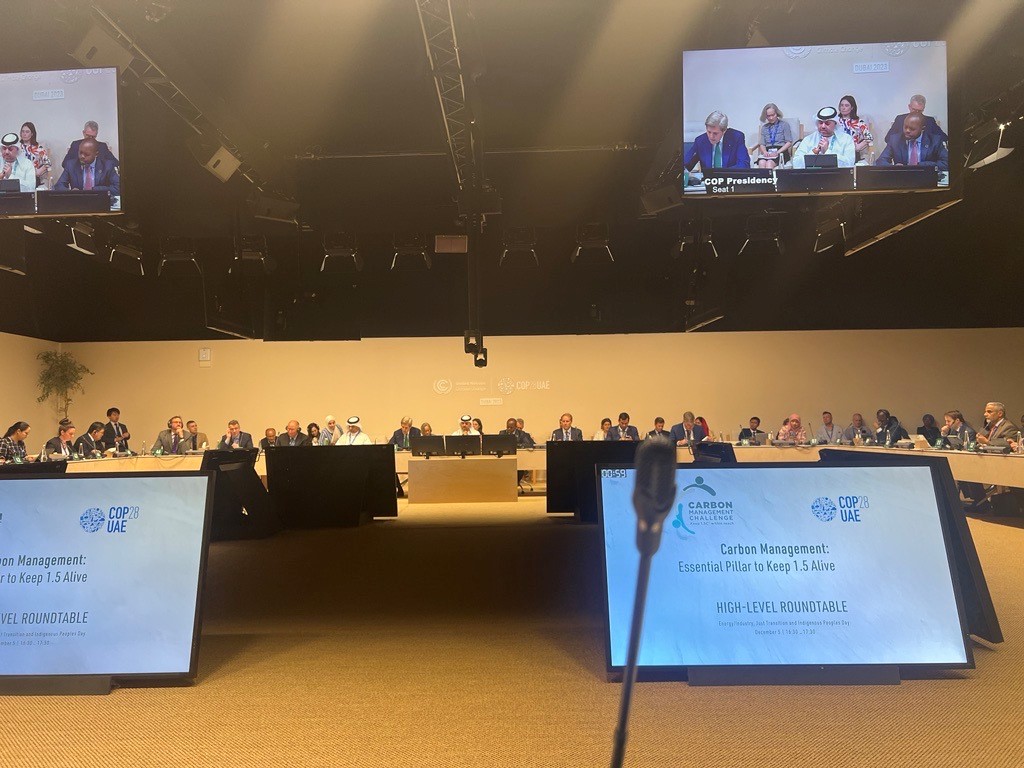Keeping 1.5 Alive – By Ruth Herbert, Chief Executive, Carbon Capture & Storage Association
Attending my third Conference of the Parties since joining the Carbon Capture and Storage Association, I felt that familiar pang of excitement tinged with dread. Would this COP deliver real progress, what would be announced on carbon management, would the debate on fossil fuels be all-consuming, what would be the outcome of the global stocktake and would it lead to further action, and what does 70,000 people even look like?
Compared to previous years it felt bigger than ever, but when you consider the scale of what we need to achieve to decarbonise the lives of over 8 billion people living on this planet, delegates are a fairly small contingent (less than one thousandth of a percent of the world’s population) and the clear message from the outset is that collaboration is essential if we are to achieve the Paris goal of limiting warming to 1.5 degrees (or “North Star” in COP-speak). Although there had been a lot of debate about the role of business at COPs, I was buoyed by the messaging from Christiana Figueres in her recent podcast that the time for negotiating is drawing to a close and it is time to move into implementation. Implementation is definitely what business is interested in.
Moving into delivery
The past year has seen Carbon Capture, Utilisation and Storage (CCUS) move into the delivery phase around the world. Many who follow this topic will be aware that in Europe, Norway has almost finished building its flagship Northern Lights facility, which will be ready to store CO2 from next year. With the capture on a cement plant in Brevik, Norway, close to completion and the Final Investment Decision on the Porthos Cluster in Rotterdam taken just over a month ago, Europe’s first-mover full-scale CCS projects are underway, providing confidence to rest of the industry. In the US, hundreds of projects are moving forward on the back of the tax credits available under the Inflation Reduction Act. What was striking at COP, however, was how much CCUS China is building and how many developing countries are putting together deployment plans, having included CCUS in their NDCs. This was evident from pavilion agendas, many of which featured CCUS side events, as well as the traffic to our booth, where many officials from the global south discussed their plans for CCUS, driven by their desire to continue to industrialise whilst they also decarbonise.
Carbon Management Challenge
It was no surprise then that the Presidency Roundtable on the Carbon Management Challenge, chaired by James Mwangi, included five new joiners to the initiative – Iceland, Kenya, Mozambique, Netherlands and Senegal – who joined existing members Australia, Brazil, Canada, Denmark, Egypt, European Commission, Indonesia, Japan, Saudi Arabia, Norway, Romania, Sweden, UAE, UK and US. Fatih Birol set the scene by saying that fossils fuels would need to be phased out and the purpose of the Challenge was to urgently deal with the emissions sources we have today. This was an important moment and a narrative echoed by several countries in their national statements, that CCUS should be prioritised on hard-to-abate sectors. This chimed with the prior announcement on the same day of a demand-side policy from the governments of Canada, Germany, UK and US, who pledged to procure low emissions steel, cement and concrete – a policy move that, if followed by others, could really start to drive the business case for industrial CCS. US Climate Envoy John Kerry and Chinese Climate Envoy Xie both referred to the Sunnylands agreement on 14 November between President Biden and President Xi Jinping, where both countries had committed to advance at least five large-scale CCUS projects each by 2030.

“Gigatonne scale per annum”
However, the big news announced at the CMC Roundtable was the call to action – a new commitment by member countries to collectively aim to capture and store carbon dioxide at gigatonne scale per annum by 2030. That’s a billion tonnes a year. To put this in context, the Brevik plant aims to capture around 800,000 tonnes per annum, so 0.08% of the target. Netherlands stated that they were already well on the way to contributing 2.5Mtpa, a quarter of a percent of the target. The UK’s four CCUS clusters, which the government hopes will deliver up to 30 million tonnes a year by 2030, would contribute just 3% of the goal. We heard about many plans from member countries, but it was clear that current commitments would fall short of 1 GT and developing countries would want support on costs to deliver projects.
No time to waste…
So my take away was that the Challenge is going to need more members or to step up existing national plans significantly. The good news is that China and Bahrain both made supportive statements during the roundtable and Netherlands suggested that other EU countries were likely to join going forward. For an initiative like this to launch in week 1, amidst all the tension of the debate on fossil fuels, looked like an impressive achievement for the Presidency and the secretariat of the Clean Energy Ministerial. As an observer in the room representing CCUS businesses, it was clear to me that were we all going to be very busy indeed with projects, whilst at the same time needing to support the putting in place of regulatory, planning and incentive frameworks in countries that are starting out on this journey. A key pillar of the CMC, alongside putting in place national targets and policies, is participating in multilateral initiatives with other countries to share knowledge so we can all move quicker. It’s clear there’s no time to waste – we now need to implement.